Size Effect of Shear Strength of Recycled Concrete Beam without Web Reinforcement: Testing and Explicit Finite Element Simulation
Abstract
1. Introduction
2. Overview of Physical Tests
2.1. Specimen Design
2.2. Loading Equipment and Loading System
3. Overview of Simulation Test
3.1. Physical Discrete Setting and Contact Conditions
3.2. Material Constitutive Model
3.3. Loading System and Solution Algorithm Configuration
4. Results and Discussion
4.1. Failure Phenomenon and Characteristic Stress Contour Plots
4.2. Ultimate Load in Test and Simulation
4.3. Law of Shear Strength and Its Value
5. Conclusions
- From the test results, the shear strength of recycled concrete beams without web reinforcement has a size effect. In general, the shear strength is inversely proportional to the effective height of the section (h0)—the smaller the h0, the more obvious the size effect. In addition, the above-mentioned relationship can be better quantitatively described by the regression fitting formula.
- Compared with the implicit finite element simulation results, the consistency between the explicit finite element simulation results and the experimental results is much higher. This situation not only shows that the damage constitutive model used in finite element modeling is reasonable, but it also shows that the explicit algorithm for solving this model is also reasonable.
Author Contributions
Funding
Institutional Review Board Statement
Informed Consent Statement
Data Availability Statement
Conflicts of Interest
References
- Buck, A.D. Recycled Concrete as a Source of Aggregate. ACI Struct. J. 1977, 74, 212–219. [Google Scholar]
- Safiuddin, M.D.; Alengaram, U.J.; Rahman, M.M.; Salam, M.M.; Jumaat, M.Z. Use of recycled concrete aggregate in concrete: A review. J. Civ. Eng. Manag. 2013, 19, 796–810. [Google Scholar] [CrossRef]
- Jia, F. What is the low carbon economy. Qiu. Shi. 2009, 19, 50. [Google Scholar]
- Livesley, R.K. The Finite Element Method in Structural and Continuum Mechanics. Aeronaut. J. 1967, 71, 659. [Google Scholar] [CrossRef]
- Ma, Z.; Tang, Q.; Wu, H.; Xu, J.; Liang, C. Mechanical properties and water absorption of cement composites with various fineness and contents of waste brick powder from C&D waste. Cem. Concr. Compos. 2020, 114, 37–58. [Google Scholar]
- Liang, C.; Pan, B.; Ma, Z.; He, Z.; Duan, Z. Utilization of CO2 curing to enhance the properties of recycled aggregate and prepared concrete: A review. Cem. Concr. Compos. 2019, 105, 34–46. [Google Scholar] [CrossRef]
- Brito, J.D.; Ferreira, J.; Pacheco, J.; Soares, D.; Guerreiro, M. Structal, material, mechanical and durability properties and behaviour of recycled aggregates concrete. J. Build. Eng. 2016, 6, 1–16. [Google Scholar] [CrossRef]
- Bravo, M. Shrinkage and creep performance of concrete with recycled aggregates from CDW plants. Mag. Concr. Res. 2017, 34, 974–995. [Google Scholar] [CrossRef]
- Zhu, Y.; Gao, G.; Xiao, J. Bending Performance Testing of Recycled Concrete Composite Slabs. Concr. Cem. Produ. 2012, 06, 49–52. [Google Scholar]
- Cao, W.; Zhang, J.; Dong, H.; Qiao, Q.; Zhou, Z. Experimental study on bending behavior of middle strength recycled concrete floor slab. J. Nat. Disasters 2015, 3, 112–119. [Google Scholar]
- Cheng, Z.; Ke, X.; Cheng, Y. Deformation Behavior and Bearing Capacity Calculation of Recycled Concrete Columns Constrained by Steel Tubular Tube. J. Appl. Mech. 2014, 31, 959–964. [Google Scholar]
- Zhou, H.; Lin, Q.; Shu, Y. The Finite Element Analysis of Waste Fiber Recycled Concrete Column Compression Performance. Appl. Mech. Mat. 2015, 3759, 269–272. [Google Scholar] [CrossRef]
- Ma, H.; Xue, J.; Liu, Y.; Zhang, X. Cyclic loading tests and shear strength of steel reinforced recycled concrete short columns. Eng. Struct. 2015, 92, 55–68. [Google Scholar] [CrossRef]
- Barbara, S.B.; Danuta, B.H.; Małgorzata, S. Influence of Recycled High-Performance Aggregate on Deformation and Load-Carrying Capacity of Reinforced Concrete Beams. Materials 2020, 13, 186–207. [Google Scholar]
- Li, S.; Zhang, Y.; Chen, W. Bending performance of unbonded prestressed basalt fiber recycled concrete beams. Eng. Struct. 2020, 221, 09–37. [Google Scholar] [CrossRef]
- Xiao, J.; Lan, Y. Experimental Study on Shear Behavior of Recycled Concrete Beams. Struct. Eng. 2004, 6, 54–58. [Google Scholar]
- Ayman, A.; Mohammad, A.; Mohammad, A.H. Predicting the contribution of recycled aggregate concrete to the shear capacity of beams without transverse reinforcement using artificial neural networks. Case Stud. Constr. Mater. 2020, 13, 1–13. [Google Scholar]
- Yong, Y.; Zhao, X.; Xu, J.; Zhang, J. Machine Learning-Based Evaluation of Shear Capacity of Recycled Aggregate Concrete Beams. J. Civ. Eng. Manag. 2020, 13, 45–52. [Google Scholar]
- Yan, G.; Sun, H.; Zhang, X.; Zhou, Y. Re-analysis of shear bearing capacity formula of recycled concrete beams. Concrete 2019, 7, 37–40. [Google Scholar]
- Mahmoud, F.A.; Boissiere, R.; Mercier, C.; Khelil, A. Shear behavior of reinforced concrete beams made from recycled coarse and fine aggregates. Structures 2020, 25, 660–669. [Google Scholar] [CrossRef]
- Su, T.; Wu, J.; Yang, G.; Jing, X.; Mueller, A. Shear Behavior of Recycled Coarse Aggregate Concrete Beams after Freezing-and-Thawing Cycles. ACI Struct. J. 2019, 116, 67–76. [Google Scholar] [CrossRef]
- Zhao, J.; Yang, Q.; Zhang, Y.; Wang, X.; Lu, C.; Liang, C.; Sun, B. Experimental study on shear performance of recycled concrete beam without reinforcements. Concrete 2018, 6, 39–42. [Google Scholar]
- Cheng, W.; Wang, T. Concrete Structure: Design Principle of Concrete Structure, 4th ed.; Wuhan University of Technology Press: Wuhan, China, 2008; pp. 71–104. [Google Scholar]
- Gu, X. Basic Principles of Concrete Structure, 1st ed.; Tongji University Press: Shanghai, China, 2004; pp. 27–28, 55–80. [Google Scholar]
- Bazant, Z.P. Size effect. Int. J. Solids Struct. 2000, 37, 69–80. [Google Scholar] [CrossRef]
- Kani, G. How Safe are Our Large Reinforced Concrete Beams? ACI Struct. J. 1967, 64, 128–141. [Google Scholar]
- Wu, W.K.; Thomas, T.C.; Shyh, J.H. Shear Strength of Reinforced Concrete Beams. ACI Struct. J. 2014, 111, 809–818. [Google Scholar]
- Collins, M.P.; Kuchma, D. How safe are our large, lightly reinforced concrete beams, slabs, and footings. ACI Struct. J. 1999, 96, 482–490. [Google Scholar]
- Bazant, Z.P.; YU, Q. Designing against size effect on shear strength of reinforced concrete beams without Stirrups:I. formulation. J. Struct. Eng. 2005, 131, 1877–1885. [Google Scholar] [CrossRef]
- Bae, Y.H.; Lee, J.H.; Yoon, Y.S. Prediction of shear strength in high-strength concrete beams considering size effect. Mag. Concr. Res. 2006, 58, 193–200. [Google Scholar] [CrossRef]
- Angelakos, D.; Bentz, E.C.; Collins, M.P. Effect of concrete strength and minimum stirrups on shear strength of large members. ACI Struct. J. 2001, 98, 290–299. [Google Scholar]
- Zienkiewicz, O.C.; Taylor, R.L. The Finite Element Method: Its Basis and Fundamentals, 6th ed.; Beijing World Publishing Corporation: Beijing, China, 2008; pp. 15–20, 46–47. [Google Scholar]
- Lv, X.; Jin, G. Nonlinear Finite Element Theory and Application of Reinforced Concrete Structure, 1st ed.; Chapter 1: Introduction; Tongji University Press: Shanghai, China, 1997; pp. 1–6. [Google Scholar]
- Jiang, J.; Lu, X. Finite Element Analysis of Concrete Structure, 1st ed.; Chapter 1: Introduction, Chapter 4: The Constitutive Relationship of Concrete Materials; Tsinghua University Press: Beijing, China, 2005; pp. 1–5, 86–100. [Google Scholar]
- Tartaglia, R.; Aniello, M.D.; Zimbru, M. Experimental and numerical study on the T -Stub behaviour with preloaded bolts under large deformations. Structures 2020, 27, 2137–2155. [Google Scholar] [CrossRef]
- Ascher, U.M.; Ruuth, S.J.; Spiteri, R.J. Implicit-Explicit Runge-Kutta Methods for Time-Dependent Partial Differential Equations. Appl. Numer. Math. 1997, 25, 151–167. [Google Scholar] [CrossRef]
- Choi, S.; Shah, S.P.; Thienel, K.C. Strain softening of concrete in compression under different end constraints. Mag. Concr. Res. 1996, 48, 103–115. [Google Scholar] [CrossRef]
- Krajcinovic, D.; Fanella, D. A micromechanical damage model for concrete. Eng. Fract. Mech. 1986, 25, 585–596. [Google Scholar] [CrossRef]
- Sabet, F.A.; Koric, S.; Idkaidek, A.; Jasiuk, I. High-Performance Computing Comparison of Implicit and Explicit Nonlinear Finite Element Simulations of Trabecular Bone. Comput. Meth. Progr. Biomed. 2020, 200, 105870. [Google Scholar] [CrossRef] [PubMed]
- Khan, S.H.; Yildirim, I.; Ozdemir, M. Convergence of an implicit algorithm for two families of nonexpansive mappings. Comput. Math. Appl. 2010, 59, 3084–3091. [Google Scholar] [CrossRef][Green Version]
- Khennane, A. Performance design of reinforced concrete slabs using commercial finite element software. Struct. Concr. 2005, 6, 141–147. [Google Scholar] [CrossRef]
- Harewood, F.J.; McHugh, P.E. Comparison of the implicit and explicit finite element methods using crystal plasticity. Comput. Mater. Sci. 2006, 39, 141–161. [Google Scholar] [CrossRef]
- Oliver, J.; Huespe, A.E.; Cante, J.C. An implicit/explicit integration scheme to increase computability of non-linear material and contact/friction problems. Comput. Meth. Appl. Mech. Eng. 2008, 197, 1865–1889. [Google Scholar] [CrossRef]
- Ted, B.; Jerry, L. Explicit algorithms for the nonlinear dynamics of shells. Comput. Meth. Appl. Mech. Eng. 1984, 42, 225–251. [Google Scholar]
- Natário, P.; Silvestre, N.; Camotim, D. Web crippling failure using quasi-static FE models. Thin-Walled Struct. 2014, 84, 34–49. [Google Scholar] [CrossRef]
- Yao, R.; Yi, G.; Li, X.; Zhang, W.; Wu, J. Simulation of failure process of reinforced concrete columns with extended finite element method. Appl. Mech. 2018, 35, 609–615. [Google Scholar]
- Yu, D.; Yi, W. Experimental study on shear capacity of reinforced concrete cantilever beams with variable cross-sections without web reinforcement. Build. Struct. 2018, 48, 7–13. [Google Scholar]
- Chen, H.; Yan, D. Concrete Construction, 2nd ed.; China Building Industry Press: Beijing, China, 1998; pp. 15–20. [Google Scholar]
- Wang, L. Elastic Theory, 1st ed.; Science Press: Beijing, China, 1978; pp. 75–78, 119–121. [Google Scholar]
- Lee, J.; Fenves, G.L. Plastic-damage model for cyclic loading of concrete structures. J. Eng. Mech. 1998, 124, 892–900. [Google Scholar] [CrossRef]
- Abaqus 6. 14 Theory Guide; Dassault Systems Simulia Corp: Providence, RI, USA, 2014.
- Abaqus 6. 14 Analysis User’s Guide (Volume III); Dassault Systems simulia Corp: Providence, RI, USA, 2014.
- Chen, Z.; Xu, J.; Zheng, H.; Su, Y.; Xue, J.; Li, J. Basic mechanical properties test and stress-strain constitutive relation of recycled concrete. J. Build. Mater. 2013, 1, 28–36. [Google Scholar]
- Guo, Z. Strength and Deformation of Concrete: Experimental Foundation and Relations, 1st ed.; Tsinghua University Press: Beijing, China, 1997; pp. 74–79. [Google Scholar]
- Zhang, Q.; Guo, Z. Investigation on shear and shear strain of concrete. J. Build. Struct. 1992, 5, 17–24. [Google Scholar]
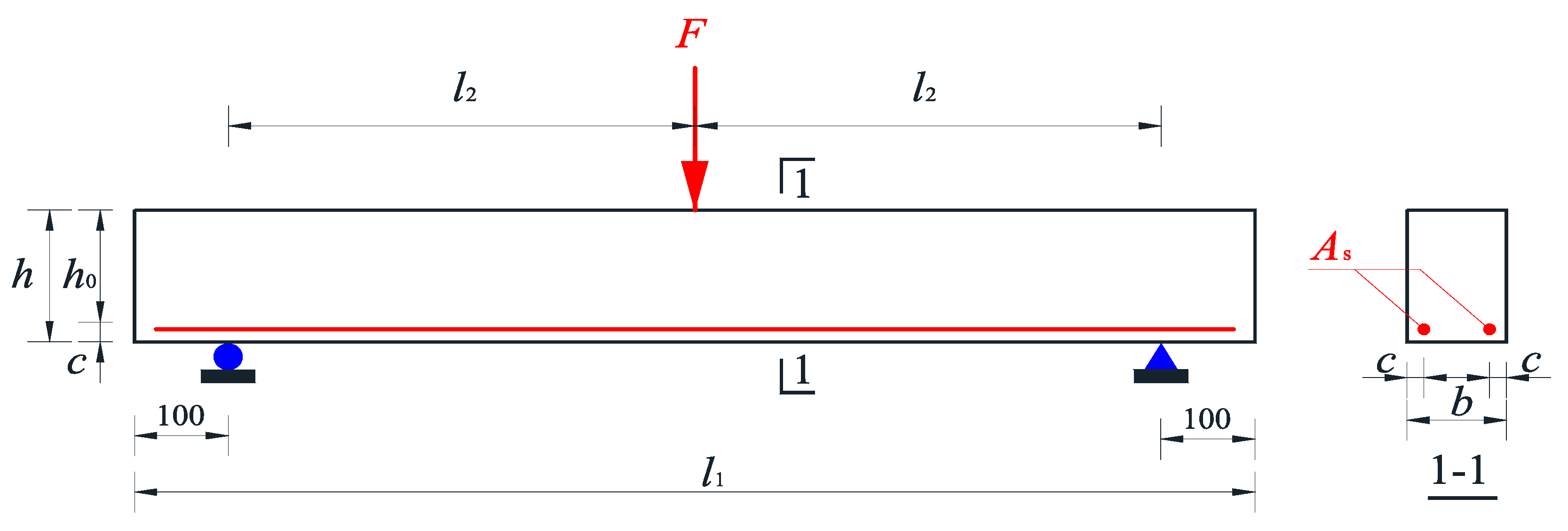
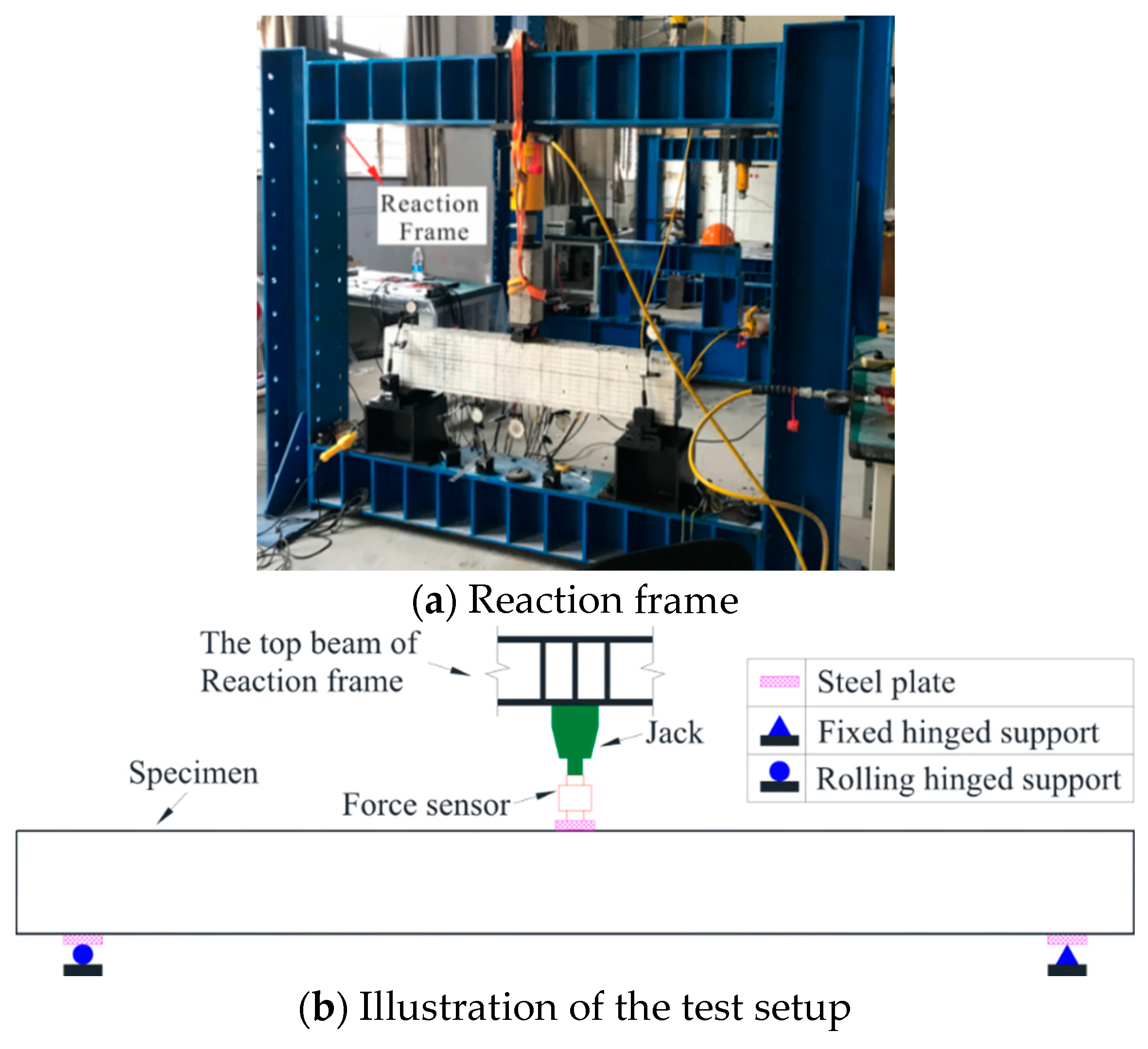
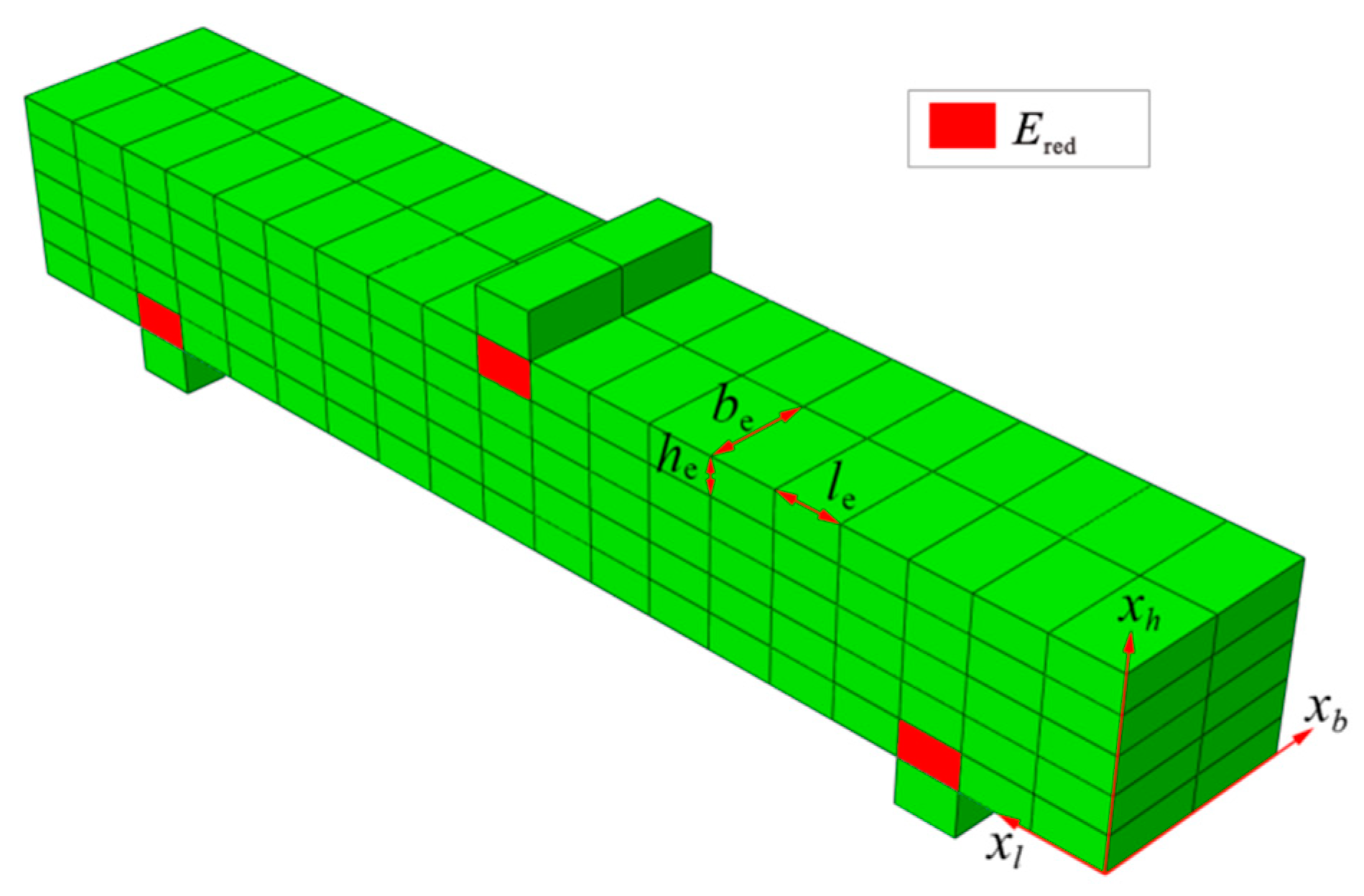
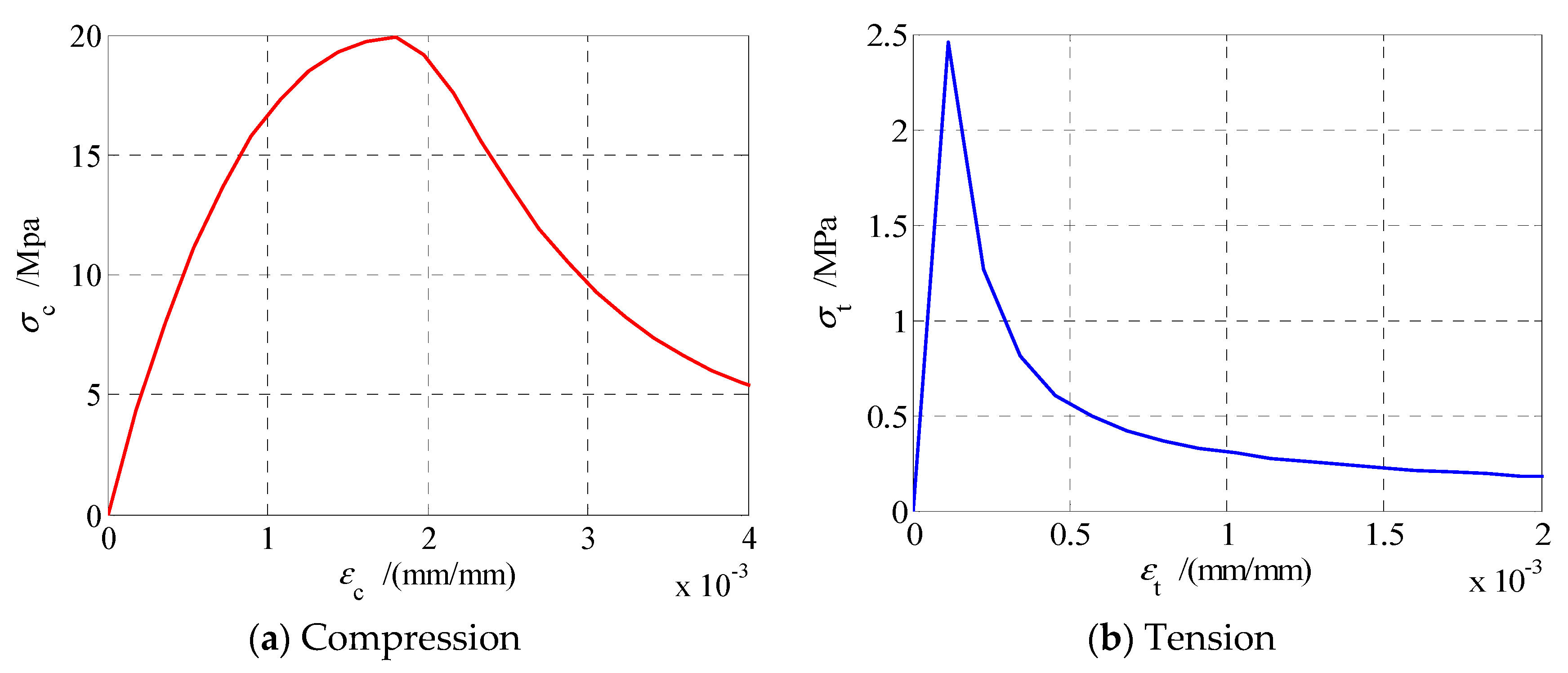

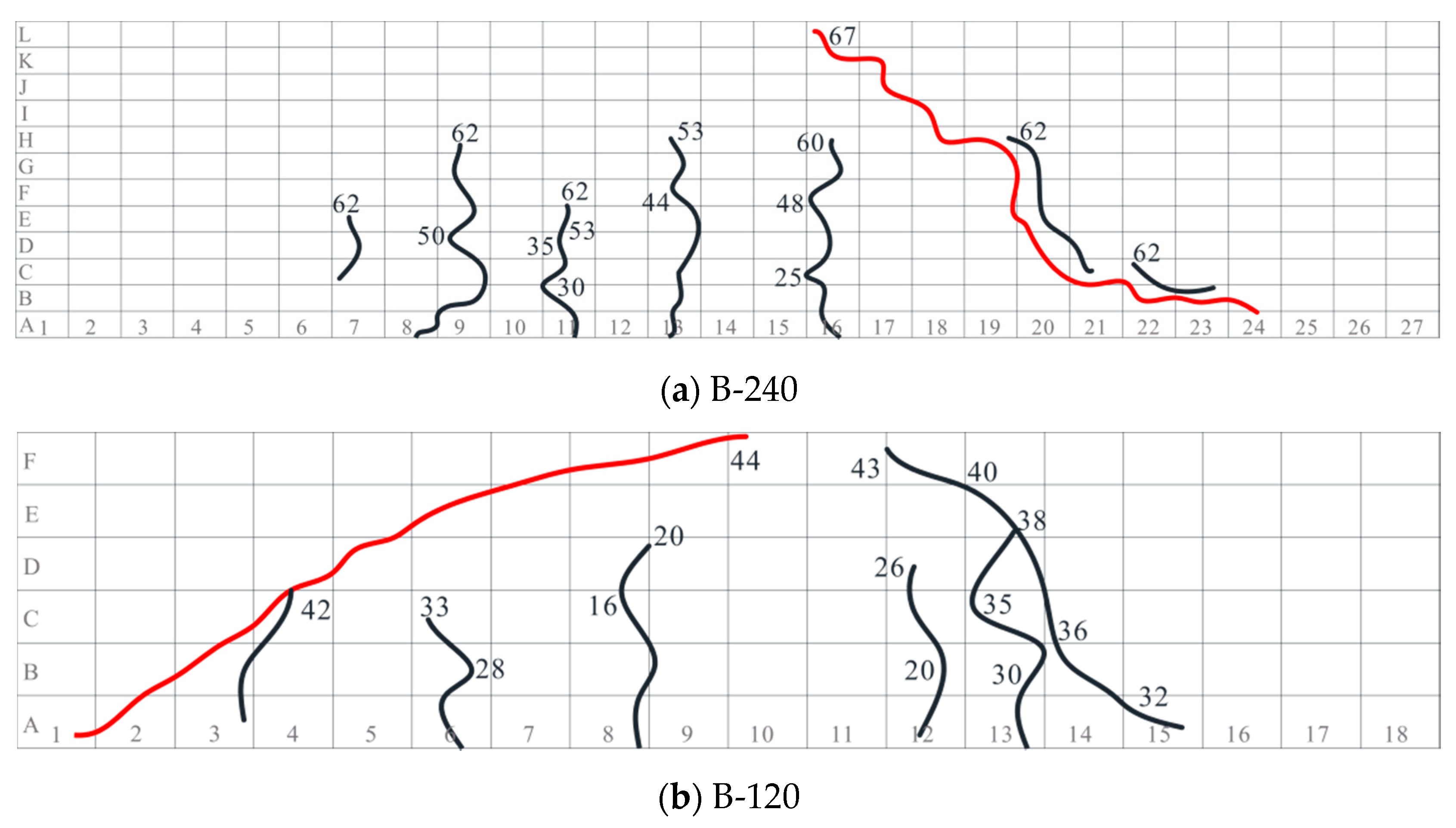

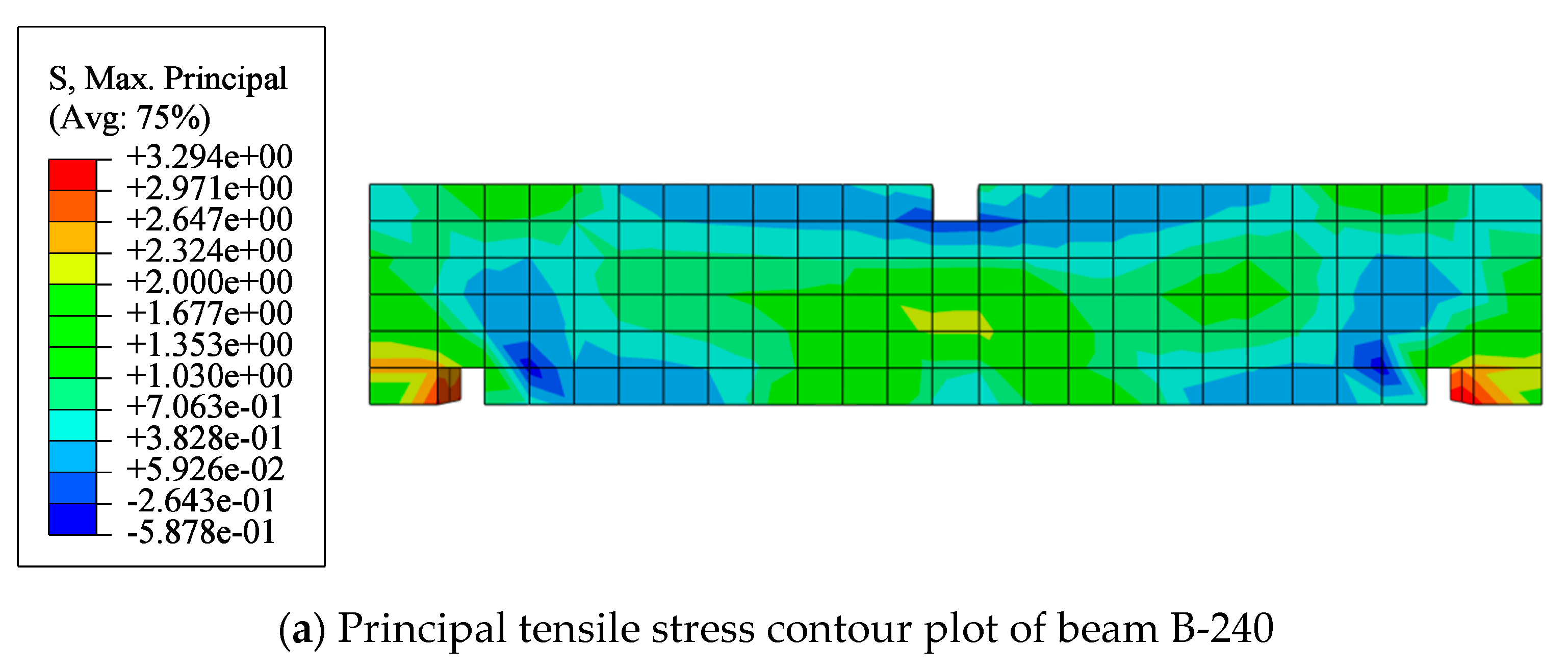

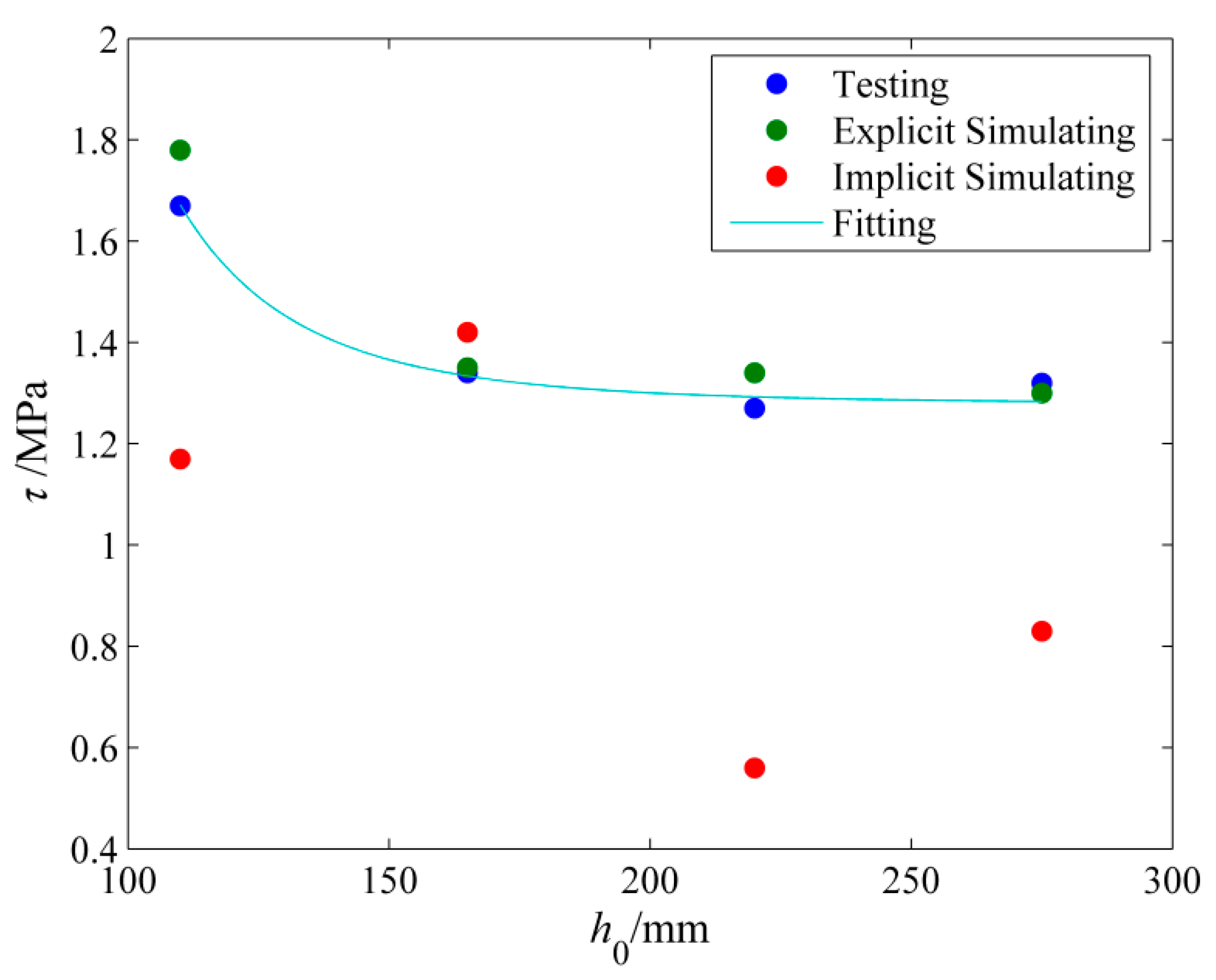
| Fine Aggregate | Particle Size/mm | Apparent Density/(kg/m3) | Bulk Density/(kg/m3) | Moisture Content/% | Fineness Modulus Number/μf | Water Absorption/% |
|---|---|---|---|---|---|---|
| Yellow sand | <5 | 2548 | 1211 | 6.8 | 1.83 | 2.9 |
| Apparent Density/(kg/m3) | Bulk Dense/(kg/m3) | Water Absorption/% | Moisture Content/% | Crush Value Index/% | Porosity/% | Porosity/% | Pudding Rate/% |
|---|---|---|---|---|---|---|---|
| 2481 | 1240 | 6.3 | 2.2 | 19.9 | 5.7 | 51.0 | 42.9 |
| Density/(kg/m3) | Compressive Strength/MPa | Flexural Strength/MPa | ||
|---|---|---|---|---|
| 3d | 28d | 3d | 28d | |
| 3051 | 17.8 | 35 | 3.9 | 7.1 |
| Replacement Rate/% | Water-Cement Ratio | Material Consumption Per Cubic Meter/(kg/m3) | |||
|---|---|---|---|---|---|
| Cement | Water | Sand | Recycled Coarse Aggregate | ||
| 100 | 1:0.34 | 623.3 | 211.8 | 491.4 | 1073.5 |
| Specimen | l1/mm | l2/mm | b/mm | h/mm | h0/mm | As/(mm2) | fy/MPa | Es/MPa |
|---|---|---|---|---|---|---|---|---|
| B-120 | 740 | 270 | 120 | 120 | 110 | 157.00 | 481 | 1.96 × 105 |
| B-180 | 1010 | 405 | 120 | 180 | 165 | 307.72 | 459 | 1.89 × 105 |
| B-240 | 1280 | 540 | 120 | 240 | 220 | 401.92 | 421 | 2.12 × 105 |
| B-300 | 1550 | 675 | 120 | 300 | 275 | 508.68 | 414 | 2.12 × 105 |
| Specimen ID | Mcr,c/(kN·m) | Fcr,c/kN | ∆F1/kN | Fcr,t/kN | Fu,c/kN | Fq,c/kN | ∆F2/kN | ∆F3/kN |
|---|---|---|---|---|---|---|---|---|
| B-120 | 1.78 | 6.60 | 1.00 | 16.00 | 33.43 | 23.40 | 1.00 | 1.00 |
| B-180 | 4.31 | 10.70 | 1.00 | 18.00 | 50.15 | 35.11 | 1.00 | 1.00 |
| B-240 | 7.93 | 14.70 | 1.00 | 30.00 | 66.87 | 46.81 | 1.00 | 2.00 |
| B-300 | 12.40 | 18.40 | 2.00 | 26.30 | 83.59 | 58.51 | 3.00 | 2.00 |
| Specimen ID | Concrete Element | Steel-Pad Element | Steel-Bar Element | ||||||
|---|---|---|---|---|---|---|---|---|---|
| le/mm | le,in/mm | le,out/mm | he/mm | be/mm | le/mm | he/mm | be/mm | les/mm | |
| B-120 | 39 | 36 | 41 | 24 | 60 | 36 | 30 | 60 | 40 |
| B-180 | 50.6 | 50.5 | 74.8 | 30 | 60 | 50.5 | 30 | 60 | 51.6 |
| B-240 | 48.9 | 51.2 | 74.4 | 40 | 60 | 51.2 | 30 | 60 | 49.6 |
| B-300 | 61.3 | 60.2 | 69 | 50 | 60 | 62.0 | 30 | 60 | 62.5 |
| σcp/MPa | εcp | σtp/MPa | εtp | αc | βc | αt | βt | φt |
|---|---|---|---|---|---|---|---|---|
| 19.88 | 1.80 × 10−3 | 2.46 | 1.06 × 10−4 | 2.34 | 4.0 | 1.1 | 1.89 | 1.7 |
| Specimen ID | Total Loading time/s | Initial Loading Displacement/mm | Final Loading Displacement/mm | Displacement Changing Law |
|---|---|---|---|---|
| B-120 | 2 | 0.0 | 0.20 | Linear |
| B-180 | 2 | 0.0 | 0.20 | Linear |
| B-240 | 2 | 0.0 | 0.40 | Linear |
| B-300 | 2 | 0.0 | 0.50 | Linear |
| Specimen ID | ||||||||
|---|---|---|---|---|---|---|---|---|
| B-120 | 44.00 | 47.06 | 30.96 | 1.67 | 1.78 | 1.17 | 6.95% | 29.64% |
| B-180 | 53.00 | 53.49 | 56.30 | 1.34 | 1.35 | 1.42 | 0.92% | 6.23% |
| B-240 | 67.00 | 70.88 | 29.80 | 1.27 | 1.34 | 0.56 | 5.79% | 55.52% |
| B-300 | 87.00 | 86.07 | 54.78 | 1.32 | 1.30 | 0.83 | 1.13% | 37.03% |
Publisher’s Note: MDPI stays neutral with regard to jurisdictional claims in published maps and institutional affiliations. |
© 2021 by the authors. Licensee MDPI, Basel, Switzerland. This article is an open access article distributed under the terms and conditions of the Creative Commons Attribution (CC BY) license (http://creativecommons.org/licenses/by/4.0/).
Share and Cite
Wang, W.; Zeng, X.; Niyonzima, E.; Gao, Y.-Q.; Yang, Q.-W.; Chen, S.-Q. Size Effect of Shear Strength of Recycled Concrete Beam without Web Reinforcement: Testing and Explicit Finite Element Simulation. Sustainability 2021, 13, 4294. https://doi.org/10.3390/su13084294
Wang W, Zeng X, Niyonzima E, Gao Y-Q, Yang Q-W, Chen S-Q. Size Effect of Shear Strength of Recycled Concrete Beam without Web Reinforcement: Testing and Explicit Finite Element Simulation. Sustainability. 2021; 13(8):4294. https://doi.org/10.3390/su13084294
Chicago/Turabian StyleWang, Wei, Xin Zeng, Emery Niyonzima, Yue-Qing Gao, Qiu-Wei Yang, and Shao-Qing Chen. 2021. "Size Effect of Shear Strength of Recycled Concrete Beam without Web Reinforcement: Testing and Explicit Finite Element Simulation" Sustainability 13, no. 8: 4294. https://doi.org/10.3390/su13084294
APA StyleWang, W., Zeng, X., Niyonzima, E., Gao, Y.-Q., Yang, Q.-W., & Chen, S.-Q. (2021). Size Effect of Shear Strength of Recycled Concrete Beam without Web Reinforcement: Testing and Explicit Finite Element Simulation. Sustainability, 13(8), 4294. https://doi.org/10.3390/su13084294






